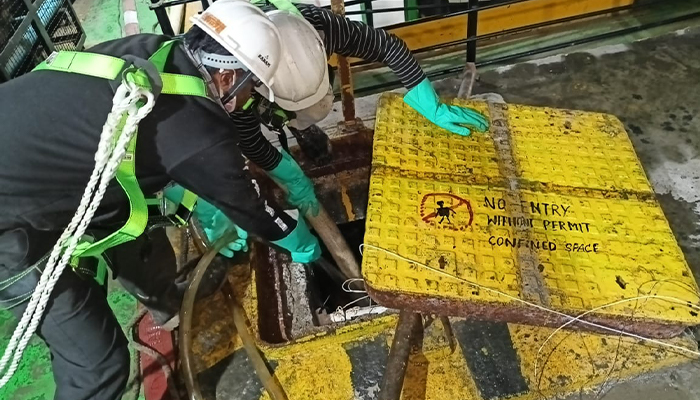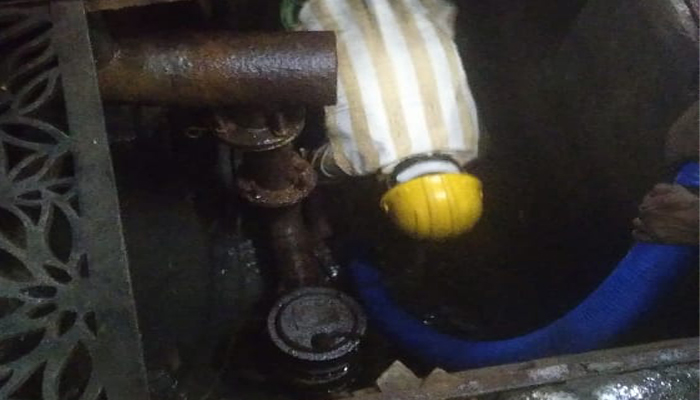Oil & Grease Tank Cleaning

Why you need Oil & Grease Tank Cleaning?
Mechanical impurities, sand, soil, heavy metal salts, paraffin, asphalt, and other heavy oil components present in the oil product would naturally settle during the lengthy storage process of an oil tank due to the difference in specific gravities. These elements will build up in the bottom of the oil tank, forming a sedimentary layer of thick, black gelatinous material. Since the sediment will continue to build up over time as the oil is stored and transported, it will eventually affect how the oil is transported and stored, necessitating routine oil tank cleaning, which is also necessary for production safety.
Oil tank cleaning procedure for dry cleaning method:
-
- Exclude oil stored in the storage tank.
- Ventilate the oil tank to exclude the gas and oil in the tank; and measure the oil tank to ensure that the concentration of oil and gas is within a safe range.
- Oil tank cleaning workers enter the tank to clean oil, water, and other sediments.
- Dry cleaning with sawdust.
- Remove the sawdust, then remove the local corrosion with copper tools.
- Clean thoroughly with the mop.
- Quality inspection and acceptance for dry cleaning.
Oil tank cleaning procedure for wet cleaning method:
- Exclude oil stored in the storage tank.
- Ventilate the oil tank to exclude the gas and oil in the tank; and measure the oil tank to ensure that the concentration of oil and gas is within a safe range.
- Oil tank cleaning workers enter the tank to clean oil, water, and other sediments.
- Wash the oil and corrosion in the storage tank with 290~490kpa high-pressure water.
- Exclude the washing of sewage as soon as possible, and clean up the tank by mop.
- Ventilate with dry wind for dehumidification.
- Remove the local corrosion with copper tools.
- Quality inspection and acceptance of wet cleaning.
Oil tank cleaning procedure for steam cleaning method:
- Exclude oil stored in the storage tank.
- Ventilate the oil tank to exclude the gas and oil in the tank; and measure the oil tank to ensure that the concentration of oil and gas is within a safe range.
- Oil tank cleaning workers enter the tank to clean oil, water, and another sediment.
- Clean the oil tank with steam, which is mainly used to clean viscous oil tanks.
- Wash the oil with high-pressure water, exclude the sewage as soon as possible, and dry clean the oil tank with sawdust.
- Remove the sawdust, then remove the local corrosion with copper tools.
- Clean thoroughly with the mop.
- Quality inspection and acceptance for dry cleaning.
Oil tank cleaning procedure for chemical cleaning method:
- Exclude oil stored in the storage tank.
- Ventilate the oil tank to exclude the gas and oil in the tank; and measure the oil tank to ensure that the concentration of oil and gas is within a safe range.
- Oil tank cleaning workers enter the tank to clean oil, water, and another sediment.
- Wash the system and equipment with a tank cleaning machine.
- Pickling and derusting for 90~120min.
- Remove acid liquid and wash the tank with clean water for 20min, natural washing liquid is appropriate.
- Exclude the sewage, and do passivation treatment two times, the first time is 3min, and the second time is about 8 min.
- After passivation 5~10min, wash the tank for 8~12min with 290kpa pressure water.
- Exclude the washing of sewage as soon as possible, and clean up the tank by mop.
- Ventilate with dry wind for dehumidification.
- Quality inspection and acceptance for dry cleaning.
Safety precautions of oil tank cleaning procedure
Oil tank cleaning is a relatively dangerous operation in the tank because the oil vapour is not only flammable, and explosive, but also toxic. Therefore, the oil tank cleaning procedure must strictly abide by the following safety requirements:
- Open the manhole, inspect the oil quality in the tank bottom, and determine the oil removal and treatment plan.
- Cleaning workers must wear work clothes, work shoes, work gloves, wear gas masks, as well as signal rope and belt. Staying time should not be too long, generally suitable for 15~20min shift work. In addition, there must be medical personnel on duty on the scene.
- Clean the residual oil sewage by broom or wooden tools, and prohibit the use of iron and steel tools.
- Must adopt effective ventilation.
Oil Tank cleaning standard:
- After cleaning the oil tank is required no rust, no impurities, no water, no grease.
- After the oil tank cleaning is completed, the two sides should be responsible for the quality inspection and acceptance, and sign the acceptance report.
- After acceptance of the tank, immediately close the manhole, connect the pipe, and restore it to its original state.
- After the end of the oil tank cleaning procedure, the site should be cleaned thoroughly according to regulations, and recorded it. Effectively ensure safe construction and civilized construction.
Know Our More Services-

STP Tank Mechanized Cleaning
Our team of professionals have a safe, scientific and efficient solution to clean your STP tanks and completely and duly disinfect these tanks.

Sump Pit & Drain Line Cleaning
The sewage and wastewater are pumped out using sump pumps and sewage pump pits. Our responsibility starts when these Sump pits gather trash that cannot be pushed out.
Why Only Clee?
Get A Free Quote Now!
We offer overhead & underground water tank cleaning services in Delhi and across the regions of NCR. Get a free estimate as per your need for your desired service. Submit your query below.